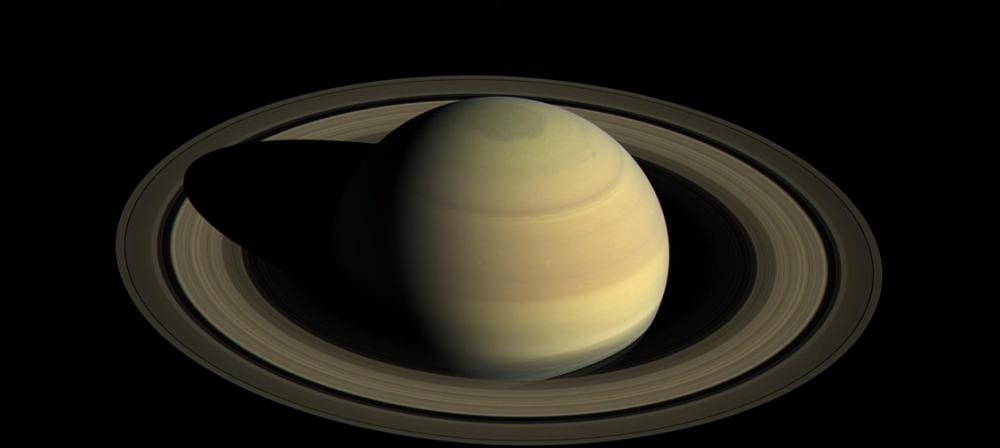The pearl of the solar system, Saturn. A gas giant planet surrounded by a magnificent ring of shining dust and rocks. It sits quietly in a remote and cold region, and thanks to its spectacular and complex rings of Saturn, Saturn is considered the second most recognizable planet in the solar system.

While all four known gas giants in the solar system have rings, none are as observable and impressive as Saturn. Like its adjacent planets, Saturn is a massive mass consisting mainly of hydrogen and helium.
It is surrounded by many mysterious moons, some of which may be suitable for life, and it has already been visited by a planetary probe, the most dedicated of NASA's Cassini spacecraft. Between 2004 and 2017, Cassini orbited Saturn 294 times, revealing in detail the true picture of this vast world and its complex ring system.
The rings are made up of billions of pieces of crushed ice and rock, ranging from tiny dust particles to huge thick chunks, some larger than the iceberg that sank the Titanic. Looking up from the clouds, you can see the rings taking on a white appearance, and each part of this dazzling natural landscape orbits Saturn at a different speed.
It extends from Saturn to 175,000 km or 282,000 km, and this dazzling ring of debris is one of the solar system's biggest features. But how long will this natural landscape last? Scientists have long wondered whether Saturn's formation was closely related to these iconic rings, or whether Saturn's rings reappeared after they formed.
According to data collected by Cassini up close, these rings are still relatively young, probably only formed between 10 million and 100 million years ago. This means that during the age of the dinosaurs, Saturn became the planet we see today. These rings may have been formed by the collision of ancient small ice moons or by the tearing of Saturn's gravity.
In a sudden event, it was torn to pieces into trillions of pieces and became one of the most distinctive-looking planets in the solar system. Unfortunately, these magnificent landscapes are changing rapidly, and based on data collected by Voyager decades ago and the latest data collected by the Cassini spacecraft, the particles that make up this huge system of halos are being consumed by Saturn itself.
This process, known by scientists as "ring rain," is said to be the result of the sun's ultraviolet radiation and tiny meteoroids bombarding ring particles and making them electrically charged by water molecules
This then causes Saturn's strong magnetic field to affect these particles and fold them toward Saturn itself. Saturn's gravity pulls this charged material along its magnetic field lines, eventually causing particles to burn as they enter Saturn's upper atmosphere. In the process, Cassini also detected more ring-like material falling into the gaseous planet's equator. Scientists calculate that about 22,000 pounds (about 10 tons) of ring rain per second is being broken down, filling an Olympic-sized swimming pool every half hour.
Saturn's shining crystal rings make the planet extremely recognizable, and Saturn's rings will still take less than 100 million years to completely disappear. While the disappearance of Saturn's rings won't affect us on Earth, it's a shame to think that the rings of this incomparably massive gaseous planet will one day disappear.
Fortunately, however, we live in a time when technology can document such a short and stunning beauty that all of us have the opportunity to see its unique beauty up close. So, if you have a telescope, aim it at Saturn and enjoy its breathtaking views for yourself! Because one day in the future, humanity will observe a planet that is different.
Related knowledge
Saturn is the sixth planet in the solar system and the second largest planet in the solar system after Jupiter. It is a gas giant with an average radius of about 9.5 times that of Earth. [22] [23] It is only one-eighth the average density of Earth; however, because Saturn is larger, it has 95 times its mass. [24] [25] [26] Saturn is named after the Roman god of wealth and agriculture.
Its astronomical symbol ( ) is derived from the Greek part of Ochrincus Manuscript 1 , which uses the two Greek letters κ and ρ plus a horizontal strip to form the symbol Κρονο ( Kronos , the second generation of gods in ancient Greek mythology ) , and is also used as the Greek name for Saturn. [27] In the 16th century, the symbol evolved into a greek letter that resembled a lowercase η with a cross at the top of the letter.
The Romans named the seventh day of the week Saturday, with Sāturnidiēs ("Saturn Day") representing Saturn. [28] Saturn's interior is most likely made up of iron-nickel and rock (compounds of silicon and oxygen). Its core is surrounded by a thick layer of metallic hydrogen, to the outside is a middle layer of liquid hydrogen and liquid helium, and to the outside is a gaseous outer layer. Due to the presence of ammonia crystals in its upper atmosphere , Saturn is pale yellow. Scientists believe that the current inside the metal hydrogen layer causes Saturn's planetary magnetic field. This magnetic field is weaker than Earth's, but due to Saturn's larger size, its magnetic moment is 580 times that of Earth.
Saturn 's magnetic field is about one-twentieth the strength of Jupiter's. [29] Although the outer atmosphere is lifeless and lacks a reference star with similar conditions, long-term survival organisms may emerge. Winds on Saturn can reach speeds of up to 1800 km/h (1100 mph; 500 m/s), which is faster than Jupiter and less than Neptune.
By: Zhao Jingjing, Teacher Zhao